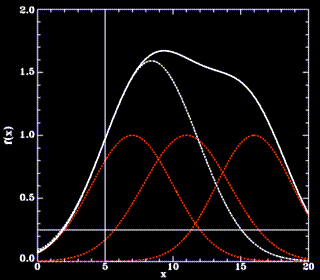Distance computation in MD Simulations
Once a density function  is computed by SOLVATE and the parameters defining f are stored in the file boundary.lis, any MD-program can access that file and use f to compute boundary forces acting on water molecules near the surface of the solute/solvent system. This force is always a function of the distance to that surface, which therefore must be computed efficiently. In this section we describe how this can be done to an accuracy sufficient for most purposes.
is computed by SOLVATE and the parameters defining f are stored in the file boundary.lis, any MD-program can access that file and use f to compute boundary forces acting on water molecules near the surface of the solute/solvent system. This force is always a function of the distance to that surface, which therefore must be computed efficiently. In this section we describe how this can be done to an accuracy sufficient for most purposes.
For the computation of the distance r between the location of a water molecule,  , and the surface point closest to
, and the surface point closest to  we first have to find that surface point. We assume that, from the construction of f as a sum of few gaussians, this surface point is sufficiently close to the intersection of a line through
we first have to find that surface point. We assume that, from the construction of f as a sum of few gaussians, this surface point is sufficiently close to the intersection of a line through  , the direction of which is given by the gradient
, the direction of which is given by the gradient  , with the surface
, with the surface  . So we have to compute that intersection point.
. So we have to compute that intersection point.
Since this cannot be done analytically, and to avoid a possible (but slow) iterative method, we approximate f for points on the line defined above beween  and the intersection point. In that region, f(solid white line) is by construction (a sum of gaussians, red, dashed lines) dominated by the gaussian next to
and the intersection point. In that region, f(solid white line) is by construction (a sum of gaussians, red, dashed lines) dominated by the gaussian next to  (thin, vertical line) and thus can be approximated by a simple (one-dimensional) gaussian function g (white dashed line),
(thin, vertical line) and thus can be approximated by a simple (one-dimensional) gaussian function g (white dashed line),

The parameters k, a, and  , which define g, are obtained from the value
, which define g, are obtained from the value  , the gradient
, the gradient  , as well as the second derivative along the gradient,
, as well as the second derivative along the gradient,  (where J is the Jacobian matrix of f at
(where J is the Jacobian matrix of f at  ),
),

The intersection point  , approximated by requiring
, approximated by requiring  , can now be calculated analytically, and the distance r we are interested in reads
, can now be calculated analytically, and the distance r we are interested in reads

As a rule of thumb, all distances required in an MD simulation are computed with an error smaller than 0.2 Å, which becomes even smaller (0.02 Å) for water molecules close to the surface.
Through a similar approximation, also the average curvature of the solvent at the intersection point, which may enter the boundary forces as a second parameter, can be obtained.
